
- Chess World Cup
- FIDE Grand Prix
- Olympiad
- World Championship
- List of strong tournaments
- List of world championships

- Checkmate patterns
- Chess openings
- Chess strategy
- Chess tactics
- Chess theory
- Endgames
- Pawn structure
- Problems/Compositions












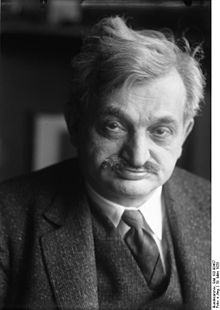 |
|
| Full name | Emanuel Lasker |
|---|---|
| Country | Germany |
| Born | December 24, 1868 Berlinchen, Prussia (now Barlinek, Poland) |
| World Champion | 1894-1921 |
Emanuel Lasker (December 24, 1868 - January 11, 1941) was a German chess player, mathematician, and philosopher who was World Chess Champion for 27 years (from 1894 to 1921). In his prime Lasker was one of the most dominant champions, and he is still generally regarded as one of the strongest players ever.
His contemporaries used to say that Lasker used a "psychological" approach to the game, and even that he sometimes deliberately played inferior moves to confuse opponents. Recent analysis, however, indicates that he was ahead of his time and used a more flexible approach than his contemporaries, which mystified many of them. Lasker knew contemporary analyses of openings well but disagreed with many of them. He published chess magazines and five chess books, but later players and commentators found it difficult to draw lessons from his methods.
Lasker made contributions to the development of other games. He was a first-class contract bridge player and wrote about bridge and other games, including Go and his own invention, Lasca. His books about games presented a problem that is still considered notable in the mathematical analysis of card games. Lasker was also a research mathematician who was known for his contributions to commutative algebra, which included proving the primary decomposition of the ideals of polynomial rings. On the other hand, his philosophical works and a drama that he co-authored received little attention.
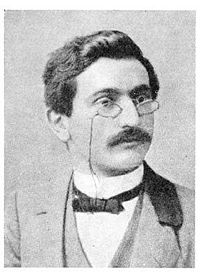 Lasker as a young man
Lasker as a young manEmanuel Lasker was born on December 24, 1868 at Berlinchen in Neumark (now Barlinek in Poland), the son of a Jewish cantor. At the age of eleven he was sent to Berlin to study mathematics, where he lived with his brother Berthold, eight years his senior, who taught him how to play chess. According to the website Chessmetrics, Berthold was among the world's top ten players in the early 1890s. To supplement their income Emanuel Lasker played chess and card games for small stakes, especially at the Café Kaiserhof.
Lasker shot up through the chess rankings in 1889, when he won the Café Kaiserhof's annual Winter tournament 1888/89 and the Hauptturnier A ("second division" tournament) at the sixth DSB Congress (German Chess Federation's congress) held in Breslau. Winning the Hauptturnier earned Lasker the title of "master". The candidates were divided into two groups of ten. The top four in each group competed in a final. Lasker won his section, with 2½ points more than his nearest rival. However, scores were reset to 0 for the final. With two rounds to go, Lasker trailed the leader, Viennese amateur von Feierfeil, by 1½ points. Lasker won both of his final games, while von Feierfeil lost in the penultimate round (being mated in 121 moves after the position was reconstructed incorrectly following an adjournment) and drew in the last round. The two players were now tied. Lasker won a playoff and garnered the master title. This enabled him to play in master-level tournaments and thus launched his chess career.
Lasker finished second in an international tournament at Amsterdam, ahead of some well-known masters, including Isidore Gunsberg (assessed as the second strongest player in the world at that time by Chessmetrics). In 1890 he finished third in Graz, then shared first prize with his brother Berthold in a tournament in Berlin. In spring 1892, he won two tournaments in London, the second and stronger of these without losing a game. At New York 1893, he won all thirteen games, one of the few times in chess history that a player has achieved a perfect score in a significant tournament.
His record in matches was equally impressive: at Berlin in 1890 he drew a short play-off match against his brother Berthold; and won all his other matches from 1889 to 1893, mostly against top-class opponents: Curt von Bardeleben (1889; ranked 9th best player in the world by Chessmetrics at that time), Jacques Mieses (1889; ranked 11th), Henry Edward Bird (1890; then 60 years old; ranked 29th), Berthold Englisch (1890; ranked 18th), Joseph Henry Blackburne (1892, without losing a game; Blackburne was aged 51 then, but still 9th in the world), Jackson Showalter (1892-93; 22nd) and Celso Golmayo Zúpide (1893; 29th). Chessmetrics calculates that Emanuel Lasker became the world's strongest player in mid-1890, and that he was in the top ten from the very beginning of his recorded career in 1889.
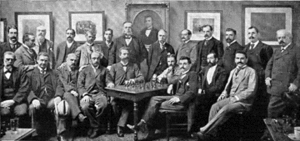 The players and tournament officials at the New York 1893 tournament
The players and tournament officials at the New York 1893 tournamentIn 1892 Lasker founded the first of his chess magazines, The London Chess Fortnightly, which was published from August 15, 1892 to July 30, 1893. In the second quarter of 1893 there was a gap of ten weeks between issues, allegedly because of problems with the printer. Shortly after its last issue Lasker traveled to the USA, where he spent the next two years.
Lasker challenged Siegbert Tarrasch, who had won three consecutive strong international tournaments (Breslau 1889, Manchester 1890, and Dresden 1892), to a match. Tarrasch haughtily declined, stating that Lasker should first prove his mettle by attempting to win one or two major international events.
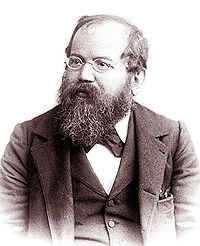 Wilhelm Steinitz, whom Lasker beat in World Championship matches in 1894 and 1896
Wilhelm Steinitz, whom Lasker beat in World Championship matches in 1894 and 1896Rebuffed by Tarrasch, Lasker challenged the reigning World Champion Wilhelm Steinitz to a match for the title. Initially Lasker wanted to play for US $5,000 a side and a match was agreed at stakes of $3,000 a side, but Steinitz agreed to a series of reductions when Lasker found it difficult to raise the money. The final figure was $2,000, which was less than for some of Steinitz' earlier matches (the final combined stake of $4,000 would be worth over $495,000 at 2006 values). Although this was publicly praised as an act of sportsmanship on Steinitz' part, Steinitz may have desperately needed the money. The match was played in 1894, at venues in New York, Philadelphia, and Montreal. Steinitz had previously declared he would win without doubt, so it came as a shock when Lasker won the first game. Steinitz responded by winning the second, and maintained the balance through the sixth. However, Lasker won all the games from the seventh to the eleventh, and Steinitz asked for a week's rest. When the match resumed, Steinitz looked in better shape and won the 13th and 14th games. Lasker struck back in the 15th and 16th, and Steinitz did not compensate for his losses in the middle of the match. Hence Lasker won convincingly with ten wins, five losses and four draws. Lasker thus became the second formally recognized World Chess Champion, and confirmed his title by beating Steinitz even more convincingly in their re-match in 1896-97 (ten wins, two losses, and five draws).
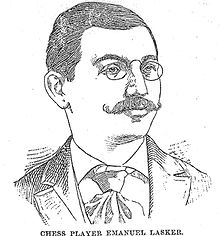 Sketch of Lasker, c. 1894
Sketch of Lasker, c. 1894Influential players and journalists belittled the 1894 match both before and after it took place. Lasker's difficulty in getting backing may have been caused by hostile pre-match comments from Gunsberg and Leopold Hoffer, who had long been a bitter enemy of Steinitz. One of the complaints was that Lasker had never played the other two members of the top four, Siegbert Tarrasch and Mikhail Chigorin - although Tarrasch had rejected a challenge from Lasker in 1892, publicly telling him to go and win an international tournament first. After the match some commentators, notably Tarrasch, said Lasker had won mainly because Steinitz was old (58 in 1894).
Emanuel Lasker answered these criticisms by creating an even more impressive playing record. Before World War I broke out his most serious "setbacks" were third place at Hastings 1895 (where he may have been suffering from the after-effects of typhoid fever), a tie for second at Cambridge Springs 1904, and a tie for first at the Chigorin Memorial in St Petersburg 1909. He won first prizes at very strong tournaments in St Petersburg (1895-96, Quadrangular), Nuremberg (1896), London (1899), Paris (1900) and St Petersburg (1914), where he overcame a 1½-point deficit to finish ahead of the rising stars, Capablanca and Alexander Alekhine, who later became the next two World Champions. For decades chess writers have reported that Tsar Nicholas II of Russia conferred the title of "Grandmaster of Chess" upon each of the five finalists at St Petersburg 1914 (Lasker, Capablanca, Alekhine, Tarrasch and Marshall), but chess historian Edward Winter has questioned this, stating that the earliest known sources supporting this story were published in 1940 and 1942.
Read main articles: World Chess Championship 1907 and World Chess Championship 1908
Lasker's match record was as impressive between his 1896-97 re-match with Steinitz and 1914: he won all but one of his normal matches, and three of those were convincing defenses of his title. He first faced Marshall in the World Chess Championship 1907, when despite his aggressive style, Marshall could not win a single game, losing eight and drawing seven (final score: 11½−3½).
He then played Tarrasch in the World Chess Championship 1908, first at Düsseldorf then at Munich. Tarrasch firmly believed the game of chess was governed by a precise set of principles. For him the strength of a chess move was in its logic, not in its efficiency. Because of his stubborn principles he considered Lasker as a coffeehouse player who won his games only thanks to dubious tricks, while Lasker mocked the arrogance of Tarrasch who, in his opinion, shone more in salons than at the chessboard. At the opening ceremony, Tarrasch refused to talk to Lasker, only saying: "Mr. Lasker, I have only three words to say to you: check and mate!"
"Tarrasch vs Lasker, World Ch. 1908".| a | b | c | d | e | f | g | h | ||
| 8 |
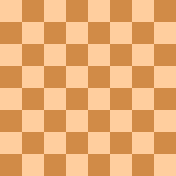
                     |
8 | |||||||
| 7 | 7 | ||||||||
| 6 | 6 | ||||||||
| 5 | 5 | ||||||||
| 4 | 4 | ||||||||
| 3 | 3 | ||||||||
| 2 | 2 | ||||||||
| 1 | 1 | ||||||||
| a | b | c | d | e | f | g | h | ||
Lasker gave a brilliant answer on the chessboard, winning four of the first five games, and playing a type of chess Tarrasch could not understand. For example, in the second game after 19 moves arose a situation (see diagram at left) in which Lasker was a pawn down, with a bad bishop and doubled pawns. At this point it appeared Tarrasch was winning, but 20 moves later he was forced to resign. Lasker eventually won by 10½−5½ (eight wins, five draws, and three losses). Tarrasch claimed the wet weather was the cause of his defeat.
Read main article: World Chess Championship 1910 (Lasker-Janowski)
In 1909 Lasker drew a short match (two wins, two losses) against Dawid Janowski, an all-out attacking Polish expatriate. Several months later they played a longer match in Paris, and chess historians still debate whether this was for the World Chess Championship. Understanding Janowski's style, Lasker chose to defend solidly so that Janowski unleashed his attacks too soon and left himself vulnerable. Lasker easily won the match 8-2 (seven wins, two draws, one loss). This victory was convincing for everyone but Janowski, who asked for a revenge match. Lasker accepted and they played a World Chess Championship match in Berlin in November-December 1910. Lasker crushed his opponent, winning 9½−1½ (eight wins, three draws, no losses). Janowski did not understand Lasker's moves, and after his first three losses he declared to Edward Lasker, "Your homonym plays so stupidly that I cannot even look at the chessboard when he thinks. I am afraid I will not do anything good in this match."
Read main article: World Chess Championship 1910 (Lasker-Schlechter)
Between his two matches against Janowski, Lasker arranged another World Chess Championship in January-February 1910 against Carl Schlechter. Schlechter was a modest gentleman, who was generally unlikely to win the major chess tournaments by his peaceful inclination, his lack of aggressiveness and his willingness to accept most draw offers from his opponents (about 80% of his games finished by a draw). The conditions of the match against Lasker are still debated among chess historians, but it seems Schlechter accepted to play under very unfavourable conditions, notably that he would need to finish two points ahead of Lasker to be declared the winner of the match, and he would need to win a revenge match to be declared World Champion. The match was originally meant to consist of 30 games, but when it became obvious that there were insufficient funds (Lasker demanded a fee of 1,000 marks per game played), the number of games was reduced to ten, making the margin of two points all the more difficult.
At the beginning, Lasker tried to attack but Schlechter had no difficulty defending, so that the first four games finished in draws. In the fifth game Lasker had a big advantage, but committed a blunder that cost him the game. Hence at the middle of the match Schlechter was one point ahead. The next four games were drawn, despite fierce play from both players. In the sixth Schlechter managed to draw a game being a pawn down. In the seventh Lasker nearly lost because of a beautiful exchange sacrifice from Schlechter. In the ninth only a blunder from Lasker allowed Schlechter to draw a lost ending. The score before the last game was thus 5-4 for Schlechter. In the tenth game Schlechter tried to win tactically and took a big advantage, but he missed a clear win at the 35th move, continued to take increasing risks and finished by losing. Hence the match was a draw and Lasker remained World Champion.
In 1911 Lasker received a challenge for a world title match against the rising star José Raúl Capablanca. Lasker was unwilling to play the traditional "first to win ten games" type of match in the semi-tropical conditions of Havana, especially as drawn games were becoming more frequent and the match might last for over six months. He therefore made a counter-proposal: if neither player had a lead of at least two games by the end of the match, it should be considered a draw; the match should be limited to the best of thirty games, counting draws; except that if either player won six games and led by at least two games before thirty games were completed, he should be declared the winner; the champion should decide the venue and stakes, and should have the exclusive right to publish the games; the challenger should deposit a forfeit of US $2,000 (equivalent to over $194,000 in 2006 values); the time limit should be twelve moves per hour; play should be limited to two sessions of 2½ hours each per day, five days a week. Capablanca objected to the time limit, the short playing times, the thirty-game limit, and especially the requirement that he must win by two games to claim the title, which he regarded as unfair. Lasker took offence at the terms in which Capablanca criticized the two-game lead condition and broke off negotiations, and until 1914 Lasker and Capablanca were not on speaking terms. However, at the 1914 St. Petersburg tournament, Capablanca proposed a set of rules for the conduct of World Championship matches, which were accepted by all the leading players, including Lasker.
Late in 1912 Lasker entered into negotiations for a world title match with Akiba Rubinstein, whose tournament record for the previous few years had been on a par with Lasker's and a little ahead of Capablanca's. The two players agreed to play a match if Rubinstein could raise the funds, but Rubinstein had few rich friends to back him and the match was never played. This situation demonstrated some of the flaws inherent in the championship system then being used. The start of World War I in summer 1914 put an end to hopes that Lasker would play either Rubinstein or Capablanca for the World Championship in the near future. Throughout World War I (1914-18) Lasker played in only two serious chess events. He convincingly won (5½−½) a non-title match against Tarrasch in 1916. In September-October 1918, shortly before the armistice, he won a quadrangular (four-player) tournament, half a point ahead of Rubinstein.
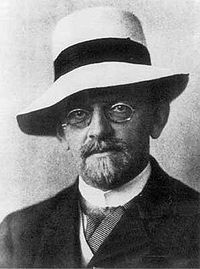 David Hilbert encouraged Lasker to obtain a Ph.D in mathematics.
David Hilbert encouraged Lasker to obtain a Ph.D in mathematics.Despite his superb playing results, chess was not Lasker's only interest. His parents recognized his intellectual talents, especially for mathematics, and sent the adolescent Emanuel to study in Berlin (where he found he also had a talent for chess). Lasker gained his abitur (high school graduation certificate) at Landsberg an der Warthe, now a Polish town named Gorzów Wielkopolski but then part of Prussia. He then studied mathematics and philosophy at the universities in Berlin, Göttingen (where David Hilbert was one of his doctoral advisors) and Heidelberg.
In 1895 Lasker published two mathematical articles in Nature. On the advice of David Hilbert he registered for doctoral studies at Erlangen during 1900-02. In 1901 he presented his doctoral thesis Über Reihen auf der Convergenzgrenze ("On Series at Convergence Boundaries") at Erlangen and in the same year it was published by the Royal Society. He was awarded a doctorate in mathematics in 1902. His most significant mathematical article, in 1905, published a theorem of which Emmy Noether developed a more generalized form, which is now regarded as of fundamental importance to modern algebra and algebraic geometry.
Lasker held short-term positions as a mathematics lecturer at Tulane University in New Orleans (1893) and Victoria University in Manchester (1901; Victoria University was one of the "parents" of the current University of Manchester). However, he was unable to secure a longer-term position, and pursued his scholarly interests independently.
In 1906 Lasker published a booklet titled Kampf (Struggle), in which he attempted to create a general theory of all competitive activities, including chess, business and war. He produced two other books which are generally categorized as philosophy, Das Begreifen der Welt (Comprehending the World; 1913) and Die Philosophie des Unvollendbar (sic; The Philosophy of the Unattainable; 1918).
In 1896-97 Lasker published his book Common Sense in Chess, based on lectures he had given in London in 1895.
Rice Gambit| a | b | c | d | e | f | g | h | ||
| 8 |

                              |
8 | |||||||
| 7 | 7 | ||||||||
| 6 | 6 | ||||||||
| 5 | 5 | ||||||||
| 4 | 4 | ||||||||
| 3 | 3 | ||||||||
| 2 | 2 | ||||||||
| 1 | 1 | ||||||||
| a | b | c | d | e | f | g | h | ||
In 1903, Lasker played in Ostend against Mikhail Chigorin, a six-game match that was sponsored by the wealthy lawyer and industrialist Isaac Rice in order to test the Rice Gambit. Lasker narrowly lost the match. Three years later Lasker became secretary of the Rice Gambit Association, founded by Rice in order to promote the Rice Gambit, and in 1907 Lasker quoted with approval Rice's views on the convergence of chess and military strategy.
In November 1904, Lasker founded Lasker's Chess Magazine, which ran until 1909.
For a short time in 1906 Emanuel Lasker was interested in the strategy game Go, but soon returned to chess. He was introduced to the game by his namesake Edward Lasker, who wrote a successful book Go and Go-Moku in 1934.
At the age of 42, in July 1911, Lasker married Martha Cohn (née Bamberger), a rich widow who was a year older than Lasker and already a grandmother. They lived in Berlin.
Martha Cohn wrote popular stories under the pseudonym "L. Marco".
During World War I, Lasker invested all of his savings in German war bonds. Since Germany lost the war, Lasker lost all his money. During the war, he wrote a book which claimed that civilization would be in danger if Germany lost the war.
Read main article: World Chess Championship 1921
In January 1920 Lasker and José Raúl Capablanca signed an agreement to play a World Championship match in 1921, noting that Capablanca was not free to play in 1920. Because of the delay, Lasker insisted on a final clause that allowed him to play anyone else for the championship in 1920, that nullified the contract with Capablanca if Lasker lost a title match in 1920, and that stipulated that if Lasker resigned the title Capablanca should become World Champion. Lasker had previously included in his agreement before World War I to play Akiba Rubinstein for the title a similar clause that if he resigned the title, it should become Rubinstein's.
A report in the American Chess Bulletin (July-August 1920 issue) said that Lasker had resigned the world title in favor of Capablanca because the conditions of the match were unpopular in the chess world. The American Chess Bulletin speculated that the conditions were not sufficiently unpopular to warrant resignation of the title, and that Lasker's real concern was that there was not enough financial backing to justify his devoting nine months to the match. When Lasker resigned the title in favor of Capablanca he was unaware that enthusiasts in Havana had just raised $20,000 to fund the match provided it was played there. When Capablanca learned of Lasker's resignation he went to the Netherlands, where Lasker was living at the time, to inform him that Havana would finance the match. In August 1920 Lasker agreed to play in Havana, but insisted that he was the challenger as Capablanca was now the champion. Capablanca signed an agreement that accepted this point, and soon afterwards published a letter confirming this. Lasker also stated that, if he beat Capablanca, he would resign the title so that younger masters could compete for it.
The match was played in March-April 1921. After four draws, the fifth game saw Lasker blunder with Black in an equal ending. Capablanca's solid style allowed him to easily draw the next four games, without taking any risks. In the tenth game, Lasker as White played a position with an isolated queen pawn but failed to create the necessary activity and Capablanca reached a superior ending, which he duly won. The eleventh and fourteenth games were also won by Capablanca, and Lasker resigned the match.
Reuben Fine and Harry Golombek attributed this to Lasker's being in mysteriously poor form. On the other hand Vladimir Kramnik thought that Lasker played quite well and the match was an "even and fascinating fight" until Lasker blundered in the last game, and explained that Capablanca was twenty years younger, a slightly stronger player, and had more recent competitive practice.
By this time Lasker was nearly 53 years old, and he never played another serious match; his only other match was a short exhibition against Frank James Marshall in 1940, which Lasker lost. After winning the New York 1924 chess tournament (1½ points ahead of Capablanca) and finishing second at Moscow in 1925 (1½ points behind Efim Bogoljubow, ½ point ahead of Capablanca), he effectively retired from serious chess.
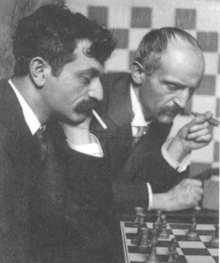 Emanuel Lasker and his brother Berthold Lasker in 1907
Emanuel Lasker and his brother Berthold Lasker in 1907During the Moscow 1925 chess tournament, Emanuel Lasker received a telegram informing him that the drama written by himself and his brother Berthold, Vom Menschen die Geschichte ("History of Mankind"), had been accepted for performance at the Lessing theatre in Berlin. Emanuel Lasker was so distracted by this news that he lost badly to Carlos Torre the same day. The play, however, was not a success.
In 1926 Lasker wrote Lehrbuch des Schachspiels, which he re-wrote in English in 1927 as Lasker's Manual of Chess. He also wrote books on other games of mental skill: Encyclopedia of Games (1929) and Das verständige Kartenspiel (means "Sensible Card Play"; 1929; English translation in the same year), both of which posed a problem in the mathematical analysis of card games; Brettspiele der Völker ("Board Games of the Nations"; 1931), which includes 30 pages about Go and a section about a game he had invented in 1911, Lasca.
In 1930, Lasker was a special correspondent for Dutch and German newspapers reporting on the Culbertson-Buller bridge match during which he became a registered teacher of the Culbertson system. He became an expert bridge player, representing Germany at international events in the early 1930s, and wrote Das Bridgespiel ("The Game of Bridge") in 1931.
In October 1928 Emanuel Lasker's brother Berthold died.
In spring 1933 Adolf Hitler started a campaign of discrimination and intimidation against Jews, depriving them of their property and citizenship. Lasker and his wife Martha, who were both Jewish, were forced to leave Germany in the same year. After a short stay in England, in 1935 they were invited to live in the USSR by Nikolai Krylenko, the Commissar of Justice who was responsible for the Moscow show trials and, in his other capacity as Sports Minister, was an enthusiastic supporter of chess. In the USSR, Lasker renounced his German citizenship and received Soviet citizenship. He took permanent residence in Moscow, and was given a post at Moscow's Institute for Mathematics and a post of trainer of the USSR national team. Lasker returned to competitive chess to make some money, finishing fifth in Zürich 1934 and third in Moscow 1935 (undefeated, ½ point behind Mikhail Botvinnik and Salo Flohr; ahead of Capablanca, Rudolf Spielmann and several Soviet masters), sixth in Moscow 1936 and seventh equal in Nottingham 1936. His performance in Moscow 1935 at age 66 was hailed as "a biological miracle."
Joseph Stalin's Great Purge started at about the same time the Laskers arrived in the USSR. In August 1937, Martha and Emanuel Lasker decided to leave the Soviet Union, and they moved, via the Netherlands, to the United States (first Chicago, next New York) in October 1937. In the following year Emanuel Lasker's patron, Krylenko, was purged. Lasker tried to support himself by giving chess and bridge lectures and exhibitions, as he was now too old for serious competition. In 1940 he published his last book, The Community of the Future, in which he proposed solutions for serious political problems, including anti-Semitism and unemployment. He died of a kidney infection in New York on January 11, 1941, at the age of 72, as a charity patient at the Mount Sinai Hospital. He was buried in the Beth Olom Cemetery, Queens, New York. He was survived by his wife Martha and his sister, Mrs. Lotta Hirschberg.
Lasker was considered to have a "psychological" method of play in which he considered the subjective qualities of his opponent, in addition to the objective requirements of his position on the board. Richard Réti published a lengthy analysis of Lasker's play in which he concluded that Lasker deliberately played inferior moves that he knew would make his opponent uncomfortable. W. H. K. Pollock commented, "It is no easy matter to reply correctly to Lasker's bad moves."
Lasker himself denied the claim that he deliberately played bad moves, and most modern writers agree. According to Grandmaster Andrew Soltis and International Master John L. Watson, the features that made his play mysterious to contemporaries now appear regularly in modern play: the g2-g4 "Spike" attack against the Dragon Sicilian; sacrifices to gain positional advantage; playing the "practical" move rather than trying to find the best move; counterattacking and complicating the game before a disadvantage became serious. Former World Champion Vladimir Kramnik said, "He realized that different types of advantage could be interchangeable: tactical edge could be converted into strategic advantage and vice versa", which mystified contemporaries who were just becoming used to the theories of Steinitz as codified by Siegbert Tarrasch.
Max Euwe opined that the real reason behind Lasker's success was his "exceptional defensive technique" and that "almost all there is to say about defensive chess can be demonstrated by examples from the games of Steinitz and Lasker", with the former exemplifying passive defence and the latter an active defence.
The famous win against José Raúl Capablanca at St. Petersburg in 1914, which Lasker needed in order to retain any chance of catching up with Capablanca, is sometimes offered as evidence of his "psychological" approach. Reuben Fine describes Lasker's choice of opening, the Exchange Variation of the Ruy Lopez, as "innocuous but psychologically potent". However, an analysis of Lasker's use of this variation throughout his career concludes that he had excellent results with it as White against top-class opponents, and sometimes used it in "must-win" situations. Luděk Pachman writes that Lasker's choice presented his opponent with a dilemma: with only a ½ point lead, Capablanca would have wanted to play safe; but the Exchange Variation's pawn structure gives White an endgame advantage, and Black must use his bishop pair aggressively in the middle game to nullify this. In Kramnik's opinion, Lasker's play in this game demonstrated deep positional understanding, rather than psychology.
Fine reckoned Lasker paid little attention to the openings, but Capablanca thought Lasker knew the openings very well but disagreed with a lot of contemporary opening analysis. In fact before the 1894 world title match Lasker studied the openings thoroughly, especially Steinitz' favorite lines. In Capablanca's opinion, no player surpassed Lasker in the ability to assess a position quickly and accurately, in terms of who had the better prospects of winning and what strategy each side should adopt. Capablanca also wrote that Lasker was so adaptable that he played in no definite style, and that he was both a tenacious defender and a very efficient finisher of his own attacks.
He did everything at a high level. However, he was the first great endgame player, and instead of using his epic tactical skills solely for mating schemes, he used them for attack and, most importantly, for defense. In a way, he was the first universal player, which made him very odd indeed for those times. Like all great players, Lasker could play any type of position; however, the classic course of a Lasker game was to concede some small concession to an opponent, exchange off either one or two minor pieces and then play a game of manoeuvre where he did not necessarily stand better but in which he could keep the position balanced. When his opponent could not maintain the balance, either by over-pressing or by playing too passively, Lasker would have them. Although famed for his defence, Lasker was equally brutal in his treatment of opponents who overpressed or played passively.
Lasker followed Steinitz principles, and both demonstrated a completely different chess paradigm than the “romantic” mentality before them. Thanks to Steinitz and Lasker, positional players gradually became common (Tarrasch, Schlechter, and Rubinstein stand out.) But, while Steinitz created a new school of chess thought, Lasker’s talents were far harder for the masses to grasp; hence there was no Lasker school.
In addition to his enormous chess skill, Lasker was said to have an excellent competitive temperament: his rival Siegbert Tarrasch once said, "Lasker occasionally loses a game, but he never loses his head." Lasker enjoyed the need to adapt to varying styles and to the shifting fortunes of tournaments. Although very strong in matches, he was even stronger in tournaments. For over twenty years, he always finished ahead of the younger Capablanca: at St. Petersburg 1914, New York 1924, Moscow 1925, and Moscow 1935. Only in 1936 (15 years after their match), when Lasker was 67, did Capablanca finish ahead of him.
In 1964, Chessworld magazine published an article in which future World Champion Bobby Fischer listed the ten greatest players in history. Fischer did not include Lasker in the list, deriding him as a "coffee-house player [who] knew nothing about openings and didn't understand positional chess". In a poll of the world's leading players taken some time after Fischer's list appeared, Tal, Korchnoi, and Robert Byrne all said that Lasker was the greatest player ever. Both Pal Benko and Byrne stated that Fischer later reconsidered and said that Lasker was a great player.
Statistical ranking systems place Lasker high among the greatest players of all time. The book Warriors of the Mind places him sixth, behind Garry Kasparov, Anatoly Karpov, Fischer, Mikhail Botvinnik and Capablanca. In his 1978 book The Rating of Chessplayers, Past and Present, Arpad Elo gave retrospective ratings to players based on their performance over the best five-year span of their career. He concluded that Lasker was the joint second strongest player of those surveyed (tied with Botvinnik and behind Capablanca). The most up-to-date system, Chessmetrics, is rather sensitive to the length of the periods being compared, and ranks Lasker between fifth and second strongest of all time for peak periods ranging in length from one to twenty years. Its author, the statistician Jeff Sonas, concluded that only Kasparov and Karpov surpassed Lasker's long-term dominance of the game. By Chessmetrics' reckoning, Lasker was the number 1 player in 292 different months - a total of over 24 years. His first No. 1 rank was in June 1890, and his last in December 1926 - a span of 36½ years. Chessmetrics also considers him the strongest 67-year-old in history: in December 1935, at age 67 years and 0 months, his rating was 2691 (number 7 in the world), well above second-place Viktor Korchnoi's rating at that age (2660, number 39 in the world, in March 1998).
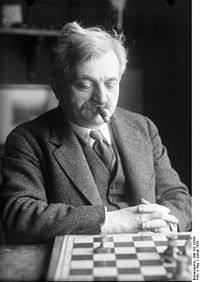 Lasker at home in Berlin, in 1933
Lasker at home in Berlin, in 1933Lasker founded no school of players who played in a similar style. Max Euwe, World Champion 1935-37 and a prolific writer of chess manuals, who had a lifetime 0-3 score against Lasker, said, "It is not possible to learn much from him. One can only stand and wonder." However, Lasker's pragmatic, combative approach had a great influence on Soviet players like Mikhail Tal and Viktor Korchnoi.
There are several "Lasker Variations" in the chess openings, including Lasker's Defense to the Queen's Gambit, Lasker's Defense to the Evans Gambit (which effectively ended the use of this gambit in tournament play until a revival in the 1990s), and the Lasker Variation in the McCutcheon Variation of the French Defense.
One of Lasker's most famous games is Lasker-Bauer, Amsterdam 1889, in which he sacrificed both bishops in a maneuver later repeated in a number of games. Similar sacrifices had already been played by Cecil Valentine De Vere and John Owen, but these were not in major events and Lasker probably had not seen them.
Lasker was shocked by the poverty in which Wilhelm Steinitz died and did not intend to die in similar circumstances. He became notorious for demanding high fees for playing matches and tournaments, and he argued that players should own the copyright in their games rather than let publishers get all the profits. These demands initially angered editors and other players, but helped to pave the way for the rise of full-time chess professionals who earn most of their living from playing, writing and teaching. Copyright in chess games had been contentious at least as far back as the mid-1840s, and Steinitz and Lasker vigorously asserted that players should own the copyright and wrote copyright clauses into their match contracts. However, Lasker's demands that challengers should raise large purses prevented or delayed some eagerly awaited World Championship matches - for example Frank James Marshall challenged him in 1904 to a match for the World Championship but could not raise the stakes demanded by Lasker until 1907. This problem continued throughout the reign of his successor Capablanca.
Some of the controversial conditions that Lasker insisted on for championship matches led Capablanca to attempt twice (1914 and 1922) to publish rules for such matches, to which other top players readily agreed.
Lasker was also a mathematician. In his 1905 article on commutative algebra, Lasker introduced the theory of primary decomposition of ideals, which has influence in the theory of Noetherian rings. Rings having the primary decomposition property are called "Laskerian rings" in his honor.
His attempt to create a general theory of all competitive activities were followed by more consistent efforts from von Neumann on game theory, and his later writings about card games presented a significant issue in the mathematical analysis of card games.
However, his dramatic and philosophical works have never been highly regarded.
Lasker was a good friend of Albert Einstein, who wrote the introduction to the posthumous biography Emanuel Lasker, The Life of a Chess Master from Dr. Jacques Hannak (1952). In this preface Einstein express his satisfaction at having met Lasker, writing:
Emanuel Lasker was undoubtedly one of the most interesting people I came to know in my later years. We must be thankful to those who have penned the story of his life for this and succeeding generations. For there are few men who have had a warm interest in all the great human problems and at the same time kept their personality so uniquely independent.
Poetess Else Lasker-Schüler was his sister-in-law. Edward Lasker, born in Kempen (Kępno), Greater Poland (then Prussia), the German-American chess master, engineer, and author, claimed that he was distantly related to Emanuel Lasker. They both played in the great New York 1924 chess tournament.
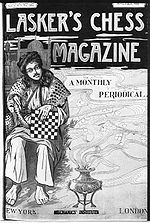
In Michael Chabon's alternate history mystery novel, The Yiddish Policemen's Union, the murdered man, Mendel Shpilman (born during the 1960's), being a chess enthusiast, uses the name "Emanuel Lasker" as an alias. The reference is clearly understood by the protagonist, Detective Meyer Landsman, because he has also studied chess.
The following table gives Lasker's placings and scores in tournaments. The first "Score" column gives the number of points on the total possible. In the second "Score" column, "+" indicates the number of won games, "−" the number of losses, and "=" the number of draws.
| Date | Location | Place | Score | Notes | |
|---|---|---|---|---|---|
| 1888/89 | Berlin (Café Kaiserhof) | 1st | 20/20 | +20 −0 =0 | |
| 1889 | Breslau "B" | 1st = | 12/15 | +11 −2 =2 | Tied with von Feyerfeil and won the play-off. This was Hauptturnier A of the sixth DSB Congress, i.e. the "second-division" tournament. |
| 1889 | Amsterdam "A" tournament | 2nd | 6/8 | +5 −1 =2 | Behind Amos Burn; ahead of James Mason, Isidor Gunsberg and others. This was the stronger of the two Amsterdam tournaments held at that time. |
| 1890 | Berlin | 1-2 | 6½/8 | +6 −1 =1 | Tied with his brother Berthold Lasker. |
| 1890 | Graz | 3rd | 4/6 | +3 −1 =2 | Behind Gyula Makovetz and Johann Hermann Bauer. |
| 1892 | London | 1st | 9/11 | +8 −1 =2 | Ahead of Mason and Rudolf Loman. |
| 1892 | London | 1st | 6½/8 | +5 −0 =3 | Ahead of Joseph Henry Blackburne, Mason, Gunsberg and Henry Edward Bird. |
| 1893 | New York City | 1st | 13/13 | +13 −0 =0 | Ahead of Adolf Albin, Jackson Showalter and a newcomer named Harry Nelson Pillsbury. |
| 1895 | Hastings | 3rd | 15½/21 | +14 −4 =3 | Behind Pillsbury and Mikhail Chigorin; ahead of Siegbert Tarrasch, Wilhelm Steinitz and the rest of a strong field. |
| 1895/96 | St. Petersburg | 1st | 11½/18 | +8 −3 =7 | A Quadrangular tournament; ahead of Steinitz (by two points), Pillsbury and Chigorin. |
| 1896 | Nuremberg | 1st | 13½/18 | +12 −3 =3 | Ahead of Géza Maróczy, Pillsbury, Tarrasch, Dawid Janowski, Steinitz and the rest of a strong field. |
| 1899 | London | 1st | 23½/28 | +20 −1 =7 | Ahead of Janowski, Pillsbury, Maróczy, Carl Schlechter, Blackburne, Chigorin and several other strong players. |
| 1900 | Paris | 1st | 14½/16 | +14 −1 =1 | Ahead of Pillsbury (by two points), Frank James Marshall, Maróczy, Burn, Chigorin and several others. |
| 1904 | Cambridge Springs | 2nd = | 11/15 | +9 −2 =4 | Tied with Janowski; two points behind Marshall; ahead of Georg Marco, Showalter, Schlechter, Chigorin, Jacques Mieses, Pillsbury and others. |
| 1906 | Trenton Falls | 1st | 5/6 | +4 −0 =2 | A Quadrangular tournament; ahead of Curt, Albert Fox and Raubitschek. |
| 1909 | St. Petersburg | 1st = | 14½/18 | +13 −2 =3 | Tied with Akiba Rubinstein; ahead of Oldřich Duras and Rudolf Spielmann (by 3½ points), Ossip Bernstein, Richard Teichmann and several other strong players. |
| 1914 | St. Petersburg | 1st | 13½/18 | +10 −1 =7 | Ahead of José Raúl Capablanca, Alexander Alekhine, Tarrasch and Marshall. This tournament had an unusual structure: there was a preliminary tournament in which eleven players played each other player once; the top five players then played a separate final tournament in which each player who made the "cut" played the other finalists twice; but their scores from the preliminary tournament were carried forward. Even the preliminary tournament would now be considered a "super-tournament". Capablanca "won" the preliminary tournament by 1½ points without losing a game, but Lasker achieved a plus score against all his opponents in the final tournament and finished with a combined score ½ point ahead of Capablanca's. |
| 1918 | Berlin | 1st | 4½/6 | +3 −0 =3 | Quadrangular tournament. Ahead of Rubinstein, Schlechter and Tarrasch. |
| 1923 | Moravská Ostrava | 1st | 10½/13 | +8 −0 =5 | Ahead of Richard Réti, Ernst Grünfeld, Alexey Selezniev, Savielly Tartakower, Max Euwe and other strong players. |
| 1924 | New York City | 1st | 16/20 | +13 −1 =6 | Ahead of Capablanca (by 1½ points), Alekhine, Marshall, and the rest of a very strong field. |
| 1925 | Moscow | 2nd | 14/20 | +10 −2 =8 | Behind Efim Bogoljubow; ahead of Capablanca, Marshall, Tartakower, Carlos Torre, other strong non-Soviet players and the leading Soviet players. |
| 1934 | Zürich | 5th | 10/15 | +9 −4 =2 | Behind Alekhine, Euwe, Salo Flohr and Bogoljubow; ahead of Bernstein, Aron Nimzowitsch, Gideon Ståhlberg and various others. |
| 1935 | Moscow | 3rd | 12½/19 | +6 −0 =13 | half a point behind Mikhail Botvinnik and Flohr; ahead of Capablanca, Spielmann, Ilya Kan, Grigory Levenfish, Andor Lilienthal, Viacheslav Ragozin and others. Emanuel Lasker was about 67 years old at the time. |
| 1936 | Moscow | 6th | 8/18 | +3 −5 =10 | Capablanca won. |
| 1936 | Nottingham | 7-8th | 8½/14 | +6 −3 =5 | Capablanca and Botvinnik tied for first place. |
Here are Lasker's results in matches. The first "Score" column gives the number of points on the total possible. In the second "Score" column, "+" indicates the number of won games, "−" the number of losses, and "=" the number of draws.
| Date | Opponent | Result | Location | Score | Notes | |
|---|---|---|---|---|---|---|
| 1889 | E.R. von Feyerfeil | Won | Breslau | 1−0 | +1 −0 =0 | Play-off match |
| 1889/90 | Curt von Bardeleben | Won | Berlin | 2½−1½ | +2 −1 =1 | |
| 1889/90 | Jacques Mieses | Won | Leipzig | 6½−1½ | +5 −0 =3 | |
| 1890 | Berthold Lasker | Drew | Berlin | ½−½ | +0 −0 =1 | Play-off match |
| 1890 | Henry Edward Bird | Won | Liverpool | 8½−3½ | +7 −2 =3 | |
| 1890 | N.T. Miniati | Won | Manchester | 4−1 | +3 −0 =2 | |
| 1890 | Berthold Englisch | Won | Vienna | 3½−1½ | +2 −0 =3 | |
| 1891 | Francis Joseph Lee | Won | London | 1½−½ | +1 −0 =1 | |
| 1892 | Joseph Henry Blackburne | Won | London | 8−2 | +6 −0 =4 | |
| 1892 | Bird | Won | Newcastle upon Tyne | 5−0 | +5 −0 =0 | |
| 1892/93 | Jackson Showalter | Won | Logansport and Kokomo, Indiana | 7−3 | +6 −2 =2 | |
| 1893 | Celso Golmayo Zúpide | Won | Havana | 2½−½ | +2 −0 =1 | |
| 1893 | Andrés Clemente Vázquez | Won | Havana | 3−0 | +3 −0 =0 | |
| 1893 | A. Ponce | Won | Havana | 2−0 | +2 −0 =0 | |
| 1893 | Alfred Ettlinger | Won | New York City | 5−0 | +5 −0 =0 | |
| 1894 | Wilhelm Steinitz | Won | New York, Philadelphia, Montreal | 12−7 | +10 −5 =4 | World Championship match |
| 1896/97 | Steinitz | Won | Moscow | 12½−4½ | +10 −2 =5 | World Championship match |
| 1901 | Dawid Janowski | Won | Manchester | 1½−½ | +1 −0 =1 | |
| 1903 | Mikhail Chigorin | Lost | Brighton | 2½−3½ | +1 −2 =3 | Rice Gambit match |
| 1907 | Frank James Marshall | Won | New York, Philadelphia, Washington, D.C., Baltimore, Chicago, Memphis |
11½−3½ | +8 −0 =7 | World Championship match |
| 1908 | Siegbert Tarrasch | Won | Düsseldorf, Munich | 10½−5½ | +8 −3 =5 | World Championship match |
| 1908 | Abraham Speijer | Won | Amsterdam | 2½−½ | +2 −0 =1 | |
| 1909 | Janowski | Drew | Paris | 2−2 | +2 −2 =0 | Exhibition match |
| 1909 | Janowski | Won | Paris | 8−2 | +7 −1 =2 | |
| 1910 | Carl Schlechter | Drew | Vienna−Berlin | 5−5 | +1 −1 =8 | World Championship match |
| 1910 | Janowski | Won | Berlin | 9½−1½ | +8 −0 =3 | World Championship match |
| 1914 | Ossip Bernstein | Drew | Moscow | 1−1 | +1 −1 =0 | Exhibition match |
| 1916 | Tarrasch | Won | Berlin | 5½−½ | +5 −0 =1 | |
| 1921 | José Raúl Capablanca | Lost | Havana | 5−9 | +0 −4 =10 | lost World Championship |
| 1940 | Frank James Marshall | Lost | New York | ½−1½ | +0 −1 =1 | exhibition match |